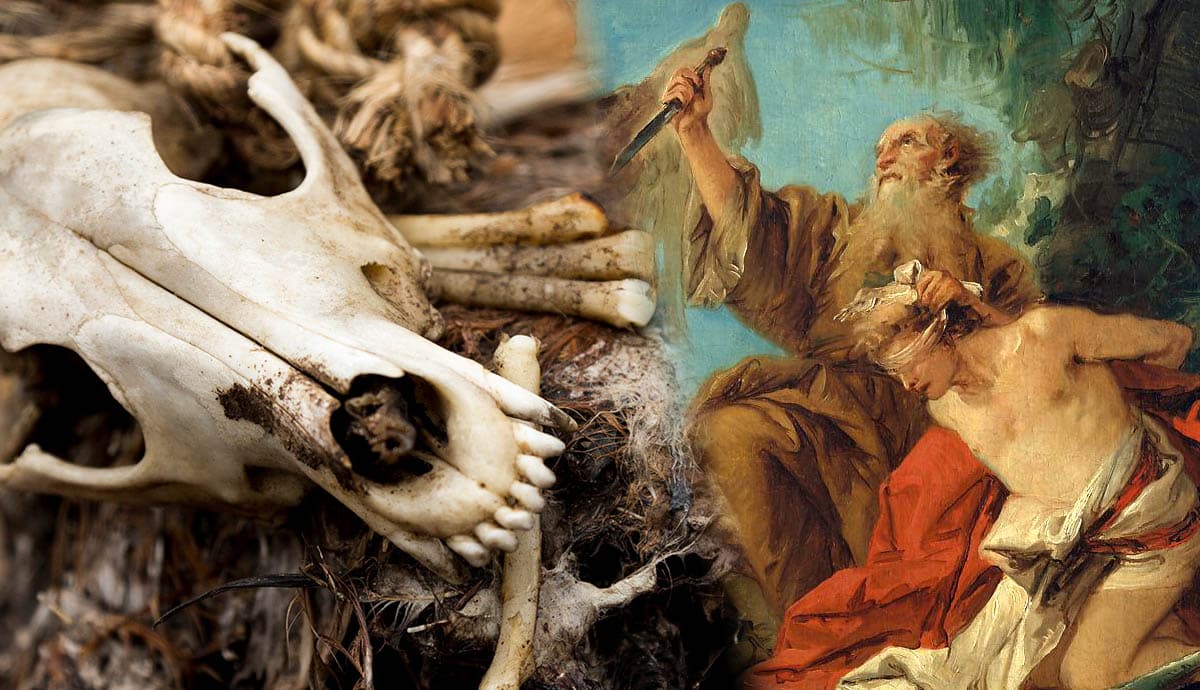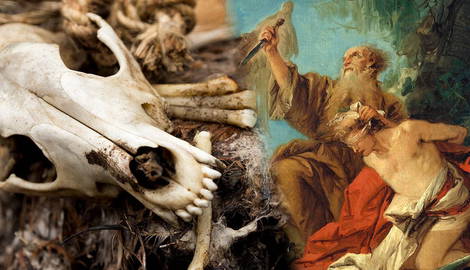
Blood sacrifices are of ancient origin. Charles S. Allisson, traces blood sacrifices as far back as the Babylonians, Canaanites, and ancient nomadic rituals. However, the Jewish God, YHWH, is the one who instituted the sacrificial system. A sacrifice is meant to appease a god. It is a gift to god from a subject who in turn expects a favor. The favor might be rain or a bountiful harvest. After the sacrifice, there is an expectancy of a blessing from a pleased god.
Blood Sacrifices in Africa: West Africa

As recent as 2018, William Haun wrote an article about animal blood sacrifices in West Africa, in a village called Tengzug. There were hundreds of small shrines. However, the most authoritative, prominent, and powerful deity represented was Tongnaab, whose name means “chief of the earth”.
Men approach the deities at the small shrines with their requests for help. These requests for help should be accompanied by a blood sacrifice. They seek different things such as fertility and prosperity. Therefore, a blood sacrifice becomes a transaction between a human being and a god. Blood is a spiritual currency. The animals for the blood sacrifices are chickens, goats, sheep, donkeys, cows, and even dogs. The spirits in these shrines are said to feed on the life-blood of the animals. Therefore, in exchange for a blessing, life has to be lost. These deities thus feed on life itself, for life is in the blood.
South Africa

In South Africa, 2011, a Commission on the Rights of Culture and Religion amended laws to respect tradition, hence animal sacrifices are still legal. Andrew Thompson points out major events at which a blood sacrifice is almost a prerequisite: birth, death and weddings.
The role of traditional healers (Sangomas) in any African nation cannot be ignored or overlooked. Ancestors are at the core of African beliefs. The belief that the dead watch over people and can be consulted for help is prevalent. Traditional healers (Sangomas) play a vital role in communicating with the ancestors. They are the link between the living and the dead. Often, to speak to, or summon the ancestors a blood sacrifice is required. Animals such as chickens, goats and cows are used.

Traditional healers, as mediators, serve the same role as the Iwa who are the intermediaries between humanity and Bondye (the Voodoo god) who cannot communicate with mere mortals. Olivia Barret notes that the Voodoo religion sacrifices animals such as chickens, goats, pigs and bulls. The sacrificial system is almost the same no matter what region or religion.
A lot of Africans believe that traditional healers help go beyond modern medicines. Certain illnesses are believed to be from the spiritual world and can only be cured by a spiritual person. A blood sacrifice may be able to heal an “unexplained sickness” (not medically explained), or else can protect against evil spirits.
Animal sacrifices have at times escalated to human sacrifices. In their article for The Zimbabwe Independent, 2018, Martin Revayi Rupiya and Phalandwa Abraham Mulaudzi exposed how South African albinos are being hunted to be sacrificed for Muthi (traditional medicine).
It is believed that Albino body parts bring people wealth, power, and economic success. The body parts are used to create potions and charms to bring wealth and success to those who purchase and consume them. The most in-demand parts are hair, bones, and genitals. This belief is prevalent in Central, Eastern, Western and Southern Africa.
Nigeria, Liberia, and Cote d’Ivoire

It seems unreal and unbelievable but Festus Adebayo has exposed current human blood sacrifice in some African countries. The Human Leopard, Alligator, and Baboon societies, have traditionally practiced blood human sacrifices. Members have carried out killings while in a state of “possession”, cutting human flesh into pieces and eating it. They believe that human flesh revitalizes them spiritually and physically.
In the 20th Century, the Liberian government outlawed these societies but some of them went underground. As disturbing and barbaric as it is, human blood sacrifice is still practiced. In the present day, Africa is facing a disturbing scenario in which human sacrifices are used for traditional medicines. It is believed that human organs are the best to use when one is seeking wealth. What happened to honest hard work?
Eid al-Adha: Muslim Animal Blood Sacrifices

Falling on the 10th day of the month of Dhu al-Hijjah, Eid is the “Festival of Sacrifice”. It is an ancient tradition that also has roots in Biblical times. Joe Sommerland describes it as an event that honors Abraham’s obedience and loyalty to Allah. Allah requested that Abraham sacrifice his only son Ishmael to him. Abraham’s obedience to this request is seen as the ultimate act of faith.
Because of his willingness to slay his only son, Allah sent the angel Gabriel to stop Abraham from sacrificing his son and replaced Ishmael with a goat. Therefore, goats, sheep, cows, or camels are sacrificed in memory of Abraham’s story, depending on the region.
Special prayers are said during the feast. However, the most important prayer is the one that is said before the blood sacrifice. It is believed that the prayers said during the Feast of Sacrifices bring peace and prosperity. The event usually lasts up to four days.
A portion of the sacrificial animal is kept for the feast, while the remainder of the meat is given to the poor and the homeless. It is unlikely that the blood sacrifice feasts will stop for it is a tradition that dates back to the prophets that must be honored.
Santeria Religion and Animal Blood Sacrifices

Presently, the followers of Santeria still practice blood sacrifices. Artemus Ward traces the Santerian roots to the Yoruba people in West Africa. This religion combines elements of African religion and Roman Catholicism. The religion spread to Cuba during the slave trade, then to the United States following the Cuban revolution.
Animal blood sacrifice is part of Santerian rituals and beliefs. Joseph M. Murphy explains how the Santerian religion is based on the development of personal relationships through divination, sacrifice, and mediumship. A blood sacrifice is essential for initiation into the faith community and the ordination of priests.
The blood sacrifice mainly involves the cutting of an animal’s throat. Animals such as chickens, goats, sheep, or turtles are sacrificed and eaten later. Eating the animal sacrifice is considered an act of sharing with the Orisha (a manifestation of God, a spirit) who only consumes the animal’s blood while the worshipers eat the meat. The Orishas are powerful but not mortal. Their survival depends on blood sacrifice and human worship. They co-depend on humans.
Human and Animal Blood Sacrifice in Sumba

Sumba is a remote Indonesian Island where human and animal blood sacrifices still exist. Pasola which is an annual festival to celebrate the harvest is the highlight of the blood sacrifice calendar. It is a brutal clan battle where men on horseback throw spears at each other to spill blood to fertilize the soil.
Harrison Jacobs notes how these horse riders are extremely accurate, throwing their spears as hard and as fast as they can, “hitting other riders in the chest, head, and eyes”. The riders are men from the ages of fourteen to forty years old. They believe that the blood sacrifice will ensure a good harvest from the rice paddies.
It is not unusual to ask for a good harvest. In ancient Japan, for example, writes Gabriella Baban, the Zenko are benevolent foxes with celestial powers. They are divine messengers of the god Inari, the protector of rice fields, prosperity, and fertility. Praying for bounty in harvests is an old tradition. In the ancient Greek world, farmers were urged to pray to chthonic gods before the harvest season (Marta Fatica, 2021). The chthonic gods were also identified as the gods of agriculture.
In Sumba, wooden blunt spears are used but they are deadly and can kill. However, human sacrifice is not punishable during Pasola. The Indonesian law system steps aside and allows the local clan to carry out its activities. If someone dies during the Pasola, there is no penalty.

Apart from human blood sacrifice, the Sumbanese also practice animal blood sacrifice. During funerals, animals are sacrificed as offerings to the Sumbanese gods and the deceased. The order of sacrificing is, dogs first, then pigs, and last, buffalo. However, when a Pasola rider dies, a horse is sacrificed. There is a belief that in doing so, the rider will have a horse in the afterlife.
Blood and sacrifice are climacterics of the Sumbanese culture. Their harvest and livelihood are tied to the sacrificial system that even the government turns a blind eye to during the four days of the Pasola.
The world’s different sacrificial systems bear so many resemblances. It is as though the system was birthed from the same womb. However, it is wise to note that where there are animal sacrifices, human sacrifice is often also present. Maybe not openly practised, but it lurks in the dark and sometimes gets exposed when a dead body is found, with missing body parts.









